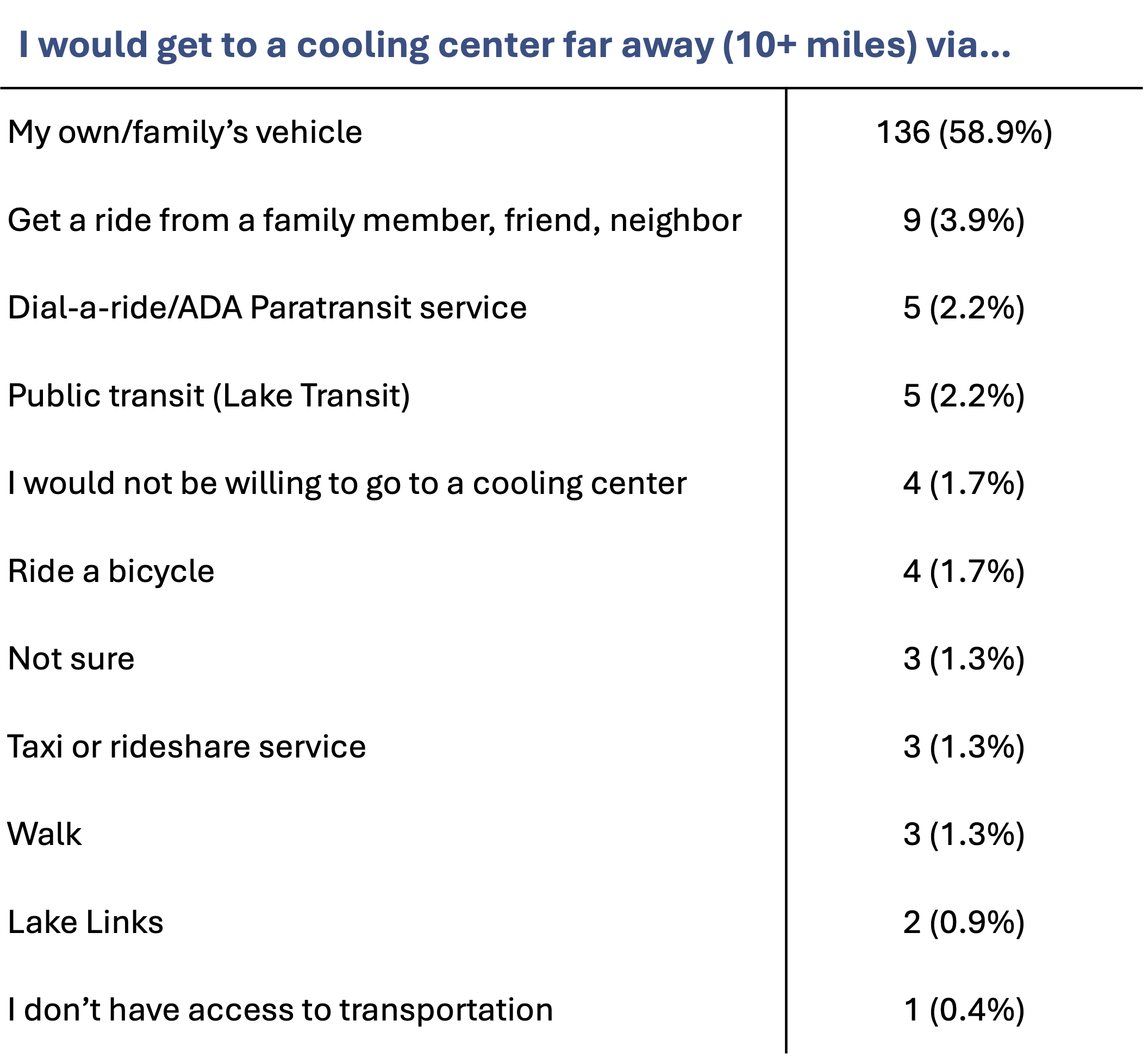About people with limited transportation and rural residents in Lake County
Around 7–10% of households in Lake County report having no access to a vehicle. This is higher than the national average (~8%) and reflects transportation challenges, especially in rural areas where public transit is limited.
Most of Lake County is considered rural, with only Clearlake and Lakeport classified as urban centers. Many rural areas face barriers to transportation, health care, and climate resilience resources.
Vulnerability to climate-driven events
- Reduced access to emergency services- It may take longer for first responders to reach rural areas during wildfires, floods, or extreme weather. Evacuations can be delayed or unsafe if people lack vehicles or depend on infrequent public transit.
- Barriers to safe shelter or resilience centers- People without transportation may be unable to reach resilience centers (e.g., cooling centers, clean air shelters) or emergency resources during heat waves, smoke events, or other emergencies. Rural communities may have fewer facilities available and greater distances to travel to access them.
- Greater reliance on at-risk infrastructure- Households in rural areas often depend on private wells, septic systems, and swamp coolers, which can be vulnerable to HABs, drought, or fire-related contamination. Power outages or road closures can isolate rural homes, cutting off communication, cooling, and water access.
- Limited access to health care and information- Healthcare facilities and public health outreach may be farther away or less frequent in rural areas. Without transportation, people may miss timely alerts, treatment, or prevention resources related to emergency preparedness and climate-driven events.
Who works with this community
In Lake County, several organizations work to support people with limited transportation and those living in rural areas, addressing the challenges posed by geographic isolation. The Lake Transit Authority provides bus services and dial-a-ride options for residents, including those in remote communities. North Coast Opportunities (NCO) offers transportation assistance for medical appointments and other essential needs, especially for seniors and low-income individuals. Lake County Behavioral Health Services ensures rural residents can access mental health and addiction services through mobile health units and transportation support. The Area Agency on Aging focuses on seniors, offering ride-sharing programs and volunteer drivers for essential trips. Additionally, Adventist Health Clear Lake helps with transportation for medical care.
Highlights from the CHARM surveys and interviews
Selected survey findings
- Nearly 60% of respondents reported they would use their own or a family member’s vehicle to access a nearby cooling center, while small proportions indicated they would rely on other options like a ride from a friend or neighbor (3.9%), paratransit (2.2%), or public transit (2.2%).

- Nearly 40% of respondents (38.1%) expressed some level of concern about transportation during a heat event, with 24% somewhat concerned and 14.3% very concerned—suggesting that transportation barriers could be a meaningful obstacle to accessing cooling centers for a substantial portion of the population.
- Over 16% of respondents reported lacking transportation to leave their home or area during a heat wave or related emergency, and 7.8% lacked transportation to reach a hospital or medical provider—highlighting the importance of emergency planning that includes mobility support for at-risk residents.
Community voices
"I had a breathing machine for my old man. So [during a PSPS] we borrowed that because we couldn't take the machine with us, you know, so to be able to keep him on oxygen and yeah, I will survive. I will survive."
"You know, having to take the bus everywhere. It's so hot. But like, not only that, just no air conditioner in the home is a drag."
"You know, [some seniors live] where they can't get out of their houses and stuff. And then it's like, you know, if their phone lines go down, you can't get a hold of them. How do you check to make sure that they have the food they need? That if electricity is out, what are they eating? Do they have it? Are they stable? You know?"
Building resilience for people with limited transportation and rural residents
Bring services to people
- Deploy mobile units for health care, cooling/clean air, and HAB-safe water distribution.
- Use pop-up clinics and outreach hubs at trusted community sites like churches, Tribal buildings, and libraries.
- Expand home-based support programs, especially for seniors and those with disabilities.
Improve transportation and evacuation access
- Create emergency transportation networks for evacuations and resilience centers
- Expand eligibility of existing transit/ride services during climate or emergency.
- Coordinate with local transit, Tribal governments, and nonprofits to reach isolated residents.
Improve risk communication
- Use multiple communication methods, including text alerts, radio, signage, and in-person outreach tailored to low-internet and low-literacy communities.
- Use trusted messengers, including Tribal and local leaders, to reach vulnerable or marginalized communities
- Regularly update maps and contact lists to ensure that vulnerable, hard-to-access residents can be quickly reached during emergencies.
Strengthen rural infrastructure
- Invest in backup power, communication systems, and fire-safe roadways for remote communities.
- Support water system upgrades and well protection from HABs, drought, and fire damage.
- Fund clean indoor air and cooling improvements for rural homes and shelters.
Expand housing and home adaptation programs
- Provide home retrofits (e.g., insulation, air filters, safe water systems) to improve shelter-in-place options.
- Increase outreach, support, and grants for fire-hardening and defensible space for homes in wildfire zones.
- Prioritize the development of resilient housing near services and away from high-risk zones.
Build local capacity and planning
- Involve rural and Tribal communities in emergency planning and resilience decisions.
- Establish resilience hubs in rural areas to provide support before, during, and after climate events.

